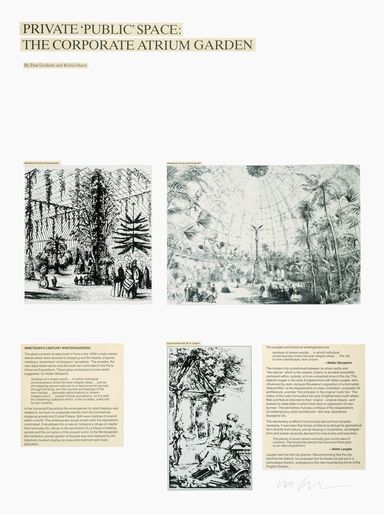Private 'Public' Space: The Corporate Atrium Garden

Dan Graham und | and Robin Hurst
Private 'Public' Space: The Corporate Atrium Garden, 1987
6 photo montages black-and-white and color photographs, photographically reproduced texts, mounted on cardboard, 101.6 x 76.2 cm each Framed 104 x 78 cm
GF0001828.00.0-1997
Artwork text
In these six panels, designed as a photo-text essay for a magazine article, Graham and the architect Hurst investigate the city at the interface between urbanity and nature. The two authors draw on Abbé Laugier’s principle of the Rustic Hut, devised under the influence of Rousseau as a critique of the new, disorderly bourgeois city and reflecting the social arcadia as a myth of enlightenment. However, nature—the antipode of urbanity and architecture—has been swallowed by the city. Relocation of inner-city cemeteries in the eighteenth century ushered in the rise of the suburbs, while in the nineteenth century, parks and boulevards (for military purposes) were laid out in cities. With the construction of glass-covered arcades, the street was transformed into an interior space for the first time, devoted, like department stores, to consumption and the display of goods. Plants were presented in the sheltered surroundings of the glass palaces at international world fairs. The idea was taken a step further at the turn of the century in the United States when the first office buildings included glass-covered inner courtyards. At the end of the 1960s many companies moved out into the suburbs; those that remained closed themselves off. The administration in New York therefore provided incentives to build covered areas for pedestrians. In some office buildings, companies introduced a series of semi-public spaces with inviting facilities such as cafés, gardens, and fountains. As the authors point out, there are still unanswered questions: how does the individual use these corporate “public spaces,” who makes decisions regarding them and are they open to everyone? A revised version of this photo-text essay titled “Corporate Arcadias” was published in Artforum at the end of 1987. Graham later pursued these concerns in a video (1992) made in connection with his installation on the roof of the Dia Art Center in New York. In his now legendary photo-text essay “Homes for America,” published by Arts Magazine in 1966, Graham analyzed the potential variations of row housing in suburban New York. (Sabine Breitwieser)






